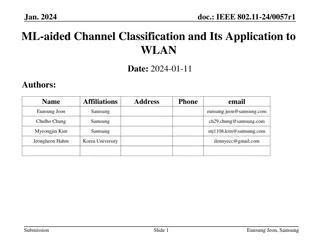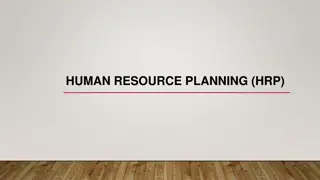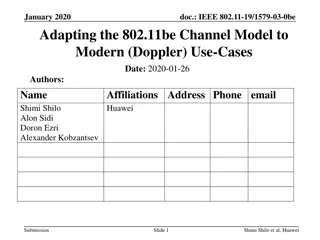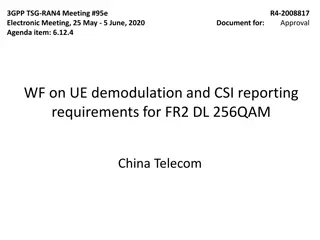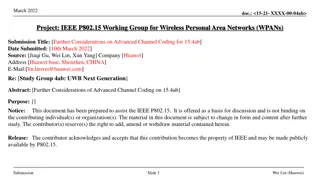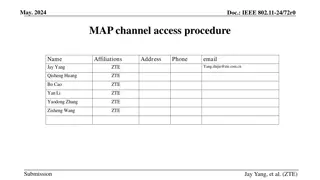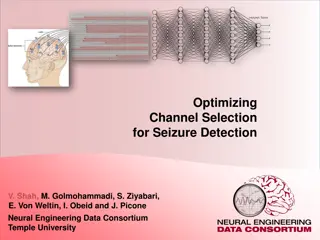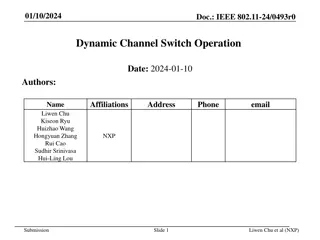
Enhanced Spectrum Sensing for Wireless Specialty Networks
This submission to IEEE P802.15 Working Group addresses the enhancement of channel access for Ultra-Wideband (UWB) communication through the expansion of the HRP channel plan. It integrates overlapping channel definitions and extensions above 10.6 GHz, aiming to improve spectrum management and coexistence in wireless networks.
Download Presentation

Please find below an Image/Link to download the presentation.
The content on the website is provided AS IS for your information and personal use only. It may not be sold, licensed, or shared on other websites without obtaining consent from the author. If you encounter any issues during the download, it is possible that the publisher has removed the file from their server.
You are allowed to download the files provided on this website for personal or commercial use, subject to the condition that they are used lawfully. All files are the property of their respective owners.
The content on the website is provided AS IS for your information and personal use only. It may not be sold, licensed, or shared on other websites without obtaining consent from the author.
E N D
Presentation Transcript
September 2022 doc. #: IEEE 802.15-22-0520-00-0000 Project: IEEE P802.15 Working Group for Wireless Specialty Networks (WSN) Submission Title: Spectrum Sensing Based Deferral Submitted: September 14, 2022 Source: Benjamin Rolfe (Blind Creek Associates) Contact: E-Mail: ben.rolfe@ieee.org Voice: NA Re: Enhanced channel access for UWB Abstract: This contribution combines the ideas from multiple contributors (see references) to expand the HRP channel plan to include overlapping channel definitions and extension above 10.6 GHz. This contribution includes material from prior submissions by multiple authors. Purpose: Consideration for inclusion in the draft amendment Notice: This document has been prepared to assist the IEEE 802. It is offered as a basis for discussion and is not binding on the contributing individual(s) or organization(s). The material in this document is subject to change in form and content after further study. The contributor(s) reserve(s) the right to add, amend or withdraw material contained herein. Release: The contributor acknowledges and accepts that this contribution becomes the property of IEEE and may be made publicly available by 802.15. Rolfe (BCA) et al
September 2022 doc. #: IEEE 802.15-22-0520-00-0000 Expanding and Extending HRP channel plan Merging of multiple ideas to support sensing, communication, ranging and everything Rolfe (BCA) et al
September 2022 doc. #: IEEE 802.15-22-0520-00-0000 Technical Guidance PAR Objective Proposed Solution (how addressed) Safeguards so that the HDR use cases will not cause disruption to low duty-cycle ranging use cases. Interference mitigation techniques to support higher density and higher traffic use cases Other coexistence improvement Backward compatibility with enhanced ranging capable devices (ERDEVs). Improved link budget and/or reduced air-time Merges the idea of overlapping channels for sensing, and data communications, with the extension of HRP above 10.6 GHz Additional channels and operating frequencies Improvements to accuracy / precision / reliability and interoperability for high-integrity ranging; Reduce complexity and power consumption; Hybrid operation with narrowband signaling to assist UWB; Enhanced native discovery and connection setup mechanisms; Sensing capabilities to support presence detection and environment mapping; Low-power low-latency streaming higher data-rate streaming allowing at least 50 Mbit/s of throughput. Support for peer-to-peer, peer-to-multi-peer, and station-to-infrastructure protocols; Infrastructure synchronization mechanisms. Rolfe (BCA) et al Slide 3
September 2022 doc. #: IEEE 802.15-22-0520-00-0000 Background (1) Contribution 15-22-0175 explores the use of overlapping channels for sensing Contribution 15-22-0409 presents the idea of overlapping channels for communications Contributions 15-22-330 and 15-22-0444 presents the idea of extending the HRP channel plan above 10.6 GHz to provide access new spectrum under consideration or approved in some regions This contributions combines these into a set of new channels that provides both overlapping channels and extension up to 12 GHz (~) The TG expressed interest in further developing these ideas Rolfe (BCA) et al Slide 4
September 2022 doc. #: IEEE 802.15-22-0520-00-0000 Background (2) Overlapping channels are useful for both sensing and communications Extending the UWB high band above 10.6 is being considered in multiple regulatory: For example, ETSI is currently working on an SRDoc (TR 103 750) that considers (t)echnical characteristics for UWB operation in the frequency band between 8.5 GHz to 10.6 GHz and 10.7 GHz to 12.4 GHz for various use cases. 802.15.4 is an international standard targeting world-wide adoption Where spectrum is available we why not be able to use it We need to be forward looking when able Rolfe (BCA) et al Slide 5
September 2022 doc. #: IEEE 802.15-22-0520-00-0000 Background (3) Considering the standard 499.2 MHz channel widths only This seems the most popular in practical use The actual last channel shown here (extend HRP up to 12.7 GHz) is a guess based on current knowledge and may need to be adjusted As more develops in regional regulations we may want to adjust and expand We ve focused on the high band for now but could also look at low band if there is interest Rolfe (BCA) et al Slide 6
September 2022 doc. #: IEEE 802.15-22-0520-00-0000 The current HRP plan Slide 7 Multiple Authors Rolfe (BCA) et al
September 2022 doc. #: IEEE 802.15-22-0520-00-0000 Band Allocation Option 1 No overlap Channel number Centre frequency (MHz) Channel start frequency (MHz) Channel end frequency (MHz) Notes Channels currently defined in the IEEE 802.15 standard 13 9,484.8 9,235.2 9,734.4 14 9,984.0 9,734.4 10,233.6 N1 10,483.2 10,233.6 10,732.8 Option 1: 499.2 MHz channels. Advantage: Ease of implementation. Problem: Transmission in the passive sensing band (10.6-10.7 GHz) will be prohibited in most, if not all, regulatory domains. Solution: Channel N1 would have to be skipped. Even if this is the case, the start frequency of N2 would be too close to 10,700 GHz, resulting in stringent implementation requirements. N2 10,982.4 10,732.8 11,232.0 N3 11,481.6 11,232.0 11,731.2 N4 11,980.8 11,731.2 12,230.4 N5 12,480.0 12,230.4 12,729.6 Slide 8 Multiple Authors Rolfe (BCA) et al
September 2022 doc. #: IEEE 802.15-22-0520-00-0000 Band Allocation Option 2 Avoiding Passive Sensing Breaking from multiple of 499.2 MHz center frequency allocation may lead to better spectrum utilization. Infinite number of solutions exist. Below is an example of what could be achieved if a gap of 1.25x499.2 MHz is introduced to protect passive band. Channel number Centre frequency (MHz) Channel start frequency (MHz) Channel end frequency (MHz) Notes Channels currently defined in the IEEE 802.15 standard 14 9,984.0 9,734.4 10,233.6 N1 11,107.2 10,857.6 11,356.8 Option 2: 1.25x499.2 MHz gap is introduced to protect passive band Problem: Breaking from multiple of 499.2 MHz center frequencies increases implementation complexity Advantages: Protection passive band 3 499.2 MHz channels below 12.4/12.7 GHz N2 11,606.4 11,356.8 11,856.0 N3 12,105.6 11,856.0 12,355.2 N4 12,604.8 12,355.2 12,854.4 Slide 9 Multiple Authors Rolfe (BCA) et al
September 2022 doc. #: IEEE 802.15-22-0520-00-0000 Overlapping Channels We include overlapping channels at 3 overlaps: 75%, 50% and 25% of the channel width (499.2 MHz) Presents this overlap over the entire high and extended high band This represents what is possible Certain regions may need to exclude some channels for various reasons We propose all new channels are optional Multiple Authors Rolfe (BCA) et al
September 2022 doc. #: IEEE 802.15-22-0520-00-0000 Other Considerates We may not want overlapping channels everywhere across the high band for various reasons Consideration of coexistence is critical Ongoing studies should provide further insights (expecting contributions soon) For example There is a reason there is a gap between 4 and 6 GHz Multiple Authors Rolfe (BCA) et al
September 2022 doc. #: IEEE 802.15-22-0520-00-0000 When we put it all together It looks something like Rolfe (BCA) et al Slide 12
September 2022 Overlapping channel plan 6-10 GHz: adding overlapping channels to HRP channel plan doc. #: IEEE 802.15-22-0520-00-0000 25 26 10 27 28 29 12 30 31 32 13 33 34 35 14 36 37 8236.8 8361.6 8486.4 8611.2 8736.0 8860.8 8985.6 9110.4 9235.2 9360.0 9484.8 9609.6 9734.4 9859.2 9984.0 10108.8 10233.6 499.2 499.2 499.2 499.2 499.2 499.2 499.2 499.2 499.2 499.2 499.2 499.2 499.2 499.2 499.2 499.2 499.2 7987.2 8112.0 8236.8 8361.6 8486.4 8611.2 8736.0 8860.8 8985.6 9110.4 9235.2 9360.0 9484.8 9609.6 9734.4 9859.2 9984.0 8486.4 8611.2 8736.0 8860.8 8985.6 9110.4 9235.2 9360.0 9484.8 9609.6 9734.4 9859.2 9984.0 10108.8 10233.6 10358.4 10483.2 Nominal Width, MHz Channel Number Center Freq, MHz Start End 5 15 16 17 6 18 19 20 8 21 22 23 9 24 6489.6 6614.4 6739.2 6864.0 6988.8 7113.6 7238.4 7363.2 7488.0 7612.8 7737.6 7862.4 7987.2 8112.0 499.2 499.2 499.2 499.2 499.2 499.2 499.2 499.2 499.2 499.2 499.2 499.2 499.2 499.2 6240.0 6364.8 6489.6 6614.4 6739.2 6864.0 6988.8 7113.6 7238.4 7363.2 7488.0 7612.8 7737.6 7862.4 6739.2 6864.0 6988.8 7113.6 7238.4 7363.2 7488.0 7612.8 7737.6 7862.4 7987.2 8112.0 8236.8 8361.6 Current Channels 75% overlap new 50% overlap new 25% overlap new Rolfe (BCA) et al
September 2022 doc. #: IEEE 802.15-22-0520-00-0000 Overlapping channel plan 6-12.7 GHz: linear extension of existing HRP channel plan 38 39 40 41 42 43 44 45 46 47 48 49 50 51 52 53 54 10358.4 10483.2 10608.0 10732.8 10857.6 10982.4 11107.2 11232.0 11356.8 11481.6 11606.4 11731.2 11856.0 11980.8 12105.6 12230.4 12355.2 499.2 499.2 499.2 499.2 499.2 499.2 499.2 499.2 499.2 499.2 499.2 499.2 499.2 499.2 499.2 499.2 499.2 25 26 10 27 28 29 12 30 31 32 13 33 34 35 14 36 37 8236.8 8361.6 8486.4 8611.2 8736.0 8860.8 8985.6 9110.4 9235.2 9360.0 9484.8 9609.6 9734.4 9859.2 9984.0 10108.8 10233.6 499.2 499.2 499.2 499.2 499.2 499.2 499.2 499.2 499.2 499.2 499.2 499.2 499.2 499.2 499.2 499.2 499.2 10108.8 10233.6 10358.4 10483.2 10608.0 10732.8 10857.6 10982.4 11107.2 11232.0 11356.8 11481.6 11606.4 11731.2 11856.0 11980.8 12105.6 10608.0 10732.8 10857.6 10982.4 11107.2 11232.0 11356.8 11481.6 11606.4 11731.2 11856.0 11980.8 12105.6 12230.4 12355.2 12480.0 12604.8 7987.2 8112.0 8236.8 8361.6 8486.4 8611.2 8736.0 8860.8 8985.6 9110.4 9235.2 9360.0 9484.8 9609.6 9734.4 9859.2 9984.0 8486.4 8611.2 8736.0 8860.8 8985.6 9110.4 9235.2 9360.0 9484.8 9609.6 9734.4 9859.2 9984.0 10108.8 10233.6 10358.4 10483.2 Nominal Width, MHz Channel Number Center Freq, MHz Start End 5 15 16 17 6 18 19 20 8 21 22 23 9 24 6489.6 6614.4 6739.2 6864.0 6988.8 7113.6 7238.4 7363.2 7488.0 7612.8 7737.6 7862.4 7987.2 8112.0 499.2 499.2 499.2 499.2 499.2 499.2 499.2 499.2 499.2 499.2 499.2 499.2 499.2 499.2 6240.0 6364.8 6489.6 6614.4 6739.2 6864.0 6988.8 7113.6 7238.4 7363.2 7488.0 7612.8 7737.6 7862.4 6739.2 6864.0 6988.8 7113.6 7238.4 7363.2 7488.0 7612.8 7737.6 7862.4 7987.2 8112.0 8236.8 8361.6 Current 75% overlap new 50% overlap new 25% overlap new New, no overlap Rolfe (BCA) et al
September 2022 Overlapping channel plan 6-12.7 GHz: linear extension of existing HRP channel plan doc. #: IEEE 802.15-22-0520-00-0000 38 39 40 41 42 43 44 45 46 47 48 49 50 51 52 53 54 10358.4 10483.2 10608.0 10732.8 10857.6 10982.4 11107.2 11232.0 11356.8 11481.6 11606.4 11731.2 11856.0 11980.8 12105.6 12230.4 12355.2 499.2 499.2 499.2 499.2 499.2 499.2 499.2 499.2 499.2 499.2 499.2 499.2 499.2 499.2 499.2 499.2 499.2 25 26 10 27 28 29 12 30 31 32 13 33 34 35 14 36 37 8236.8 8361.6 8486.4 8611.2 8736.0 8860.8 8985.6 9110.4 9235.2 9360.0 9484.8 9609.6 9734.4 9859.2 9984.0 10108.8 10233.6 499.2 499.2 499.2 499.2 499.2 499.2 499.2 499.2 499.2 499.2 499.2 499.2 499.2 499.2 499.2 499.2 499.2 10108.8 10233.6 10358.4 10483.2 10608.0 10732.8 10857.6 10982.4 11107.2 11232.0 11356.8 11481.6 11606.4 11731.2 11856.0 11980.8 12105.6 10608.0 10732.8 10857.6 10982.4 11107.2 11232.0 11356.8 11481.6 11606.4 11731.2 11856.0 11980.8 12105.6 12230.4 12355.2 12480.0 12604.8 7987.2 8112.0 8236.8 8361.6 8486.4 8611.2 8736.0 8860.8 8985.6 9110.4 9235.2 9360.0 9484.8 9609.6 9734.4 9859.2 9984.0 8486.4 8611.2 8736.0 8860.8 8985.6 9110.4 9235.2 9360.0 9484.8 9609.6 9734.4 9859.2 9984.0 10108.8 10233.6 10358.4 10483.2 Nominal Width, MHz Channel Number Center Freq, MHz Start End 5 15 16 17 6 18 19 20 8 21 22 23 9 24 6489.6 6614.4 6739.2 6864.0 6988.8 7113.6 7238.4 7363.2 7488.0 7612.8 7737.6 7862.4 7987.2 8112.0 499.2 499.2 499.2 499.2 499.2 499.2 499.2 499.2 499.2 499.2 499.2 499.2 499.2 499.2 6240.0 6364.8 6489.6 6614.4 6739.2 6864.0 6988.8 7113.6 7238.4 7363.2 7488.0 7612.8 7737.6 7862.4 6739.2 6864.0 6988.8 7113.6 7238.4 7363.2 7488.0 7612.8 7737.6 7862.4 7987.2 8112.0 8236.8 8361.6 Define channels 38 through 40 for use in regions where there may not be conflict wit passive sensing or where other mitigations may be used Current 75% overlap new 50% overlap new 25% overlap new New, no overlap Rolfe (BCA) et al
September 2022 doc. #: IEEE 802.15-22-0520-00-0000 Overlapping channel plan 6-12.7 GHz: Extension of HRP skipping 10.6-10.7 GHz 25 26 10 27 28 29 12 30 31 32 13 33 34 35 14 36 37 8236.8 8361.6 8486.4 8611.2 8736.0 8860.8 8985.6 9110.4 9235.2 9360.0 9484.8 9609.6 9734.4 9859.2 9984.0 10108.8 10233.6 499.2 499.2 499.2 499.2 499.2 499.2 499.2 499.2 499.2 499.2 499.2 499.2 499.2 499.2 499.2 499.2 499.2 38 39 40 41 42 43 44 45 46 47 48 49 50 11107.2 11232 11356.8 11481.6 11606.4 11731.2 11856.0 11980.8 12105.6 12230.4 12355.2 12480.0 12604.8 499.2 499.2 499.2 499.2 499.2 499.2 499.2 499.2 499.2 499.2 499.2 499.2 499.2 7987.2 8112.0 8236.8 8361.6 8486.4 8611.2 8736.0 8860.8 8985.6 9110.4 9235.2 9360.0 9484.8 9609.6 9734.4 9859.2 9984.0 8486.4 8611.2 8736.0 8860.8 8985.6 9110.4 9235.2 9360.0 9484.8 9609.6 9734.4 9859.2 9984.0 10108.8 10233.6 10358.4 10483.2 10857.6 10982.4 11107.2 11232.0 11356.8 11481.6 11606.4 11731.2 11856.0 11980.8 12105.6 12230.4 12355.2 11356.8 11481.6 11606.4 11731.2 11856.0 11980.8 12105.6 12230.4 12355.2 12480.0 12604.8 12729.6 12854.4 Nominal Width, MHz Channel Number Center Freq, MHz Start End 5 15 16 17 6 18 19 20 8 21 22 23 9 24 6489.6 6614.4 6739.2 6864.0 6988.8 7113.6 7238.4 7363.2 7488.0 7612.8 7737.6 7862.4 7987.2 8112.0 499.2 499.2 499.2 499.2 499.2 499.2 499.2 499.2 499.2 499.2 499.2 499.2 499.2 499.2 6240.0 6364.8 6489.6 6614.4 6739.2 6864.0 6988.8 7113.6 7238.4 7363.2 7488.0 7612.8 7737.6 7862.4 6739.2 6864.0 6988.8 7113.6 7238.4 7363.2 7488.0 7612.8 7737.6 7862.4 7987.2 8112.0 8236.8 8361.6 Current 75% overlap new 50% overlap new 25% overlap new New, no overlap Rolfe (BCA) et al
September 2022 doc. #: IEEE 802.15-22-0520-00-0000 Changes to the Standard Additional rows to table 10-9 (see next slide) Possible addition of new mask (to be considered) as discussed in prior contributions Rolfe (BCA) et al Slide 17
September 2022 doc. #: IEEE 802.15-22-0520-00-0000 Add Rows to Table 10-9 Channel number Channel number HRP UWB band HRP UWB band Center frequency (MHz) Center frequency (MHz) 16 6739.2 38 11107.2 17 6864.0 39 11232 18 7113.6 40 11356.8 19 7238.4 41 11481.6 20 7363.2 42 11606.4 21 7612.8 43 11731.2 22 7737.6 23 7862.4 44 11856.0 Extended High Band 24 8112.0 45 11980.8 25 8236.8 46 12105.6 26 8361.6 High Band 47 12230.4 27 8611.2 48 12355.2 28 8736.0 29 8860.8 49 12480.0 30 9110.4 50 12604.8 31 9235.2 32 9360.0 33 9609.6 34 9734.4 35 9859.2 36 10108.8 37 10233.6 Rolfe (BCA) et al




